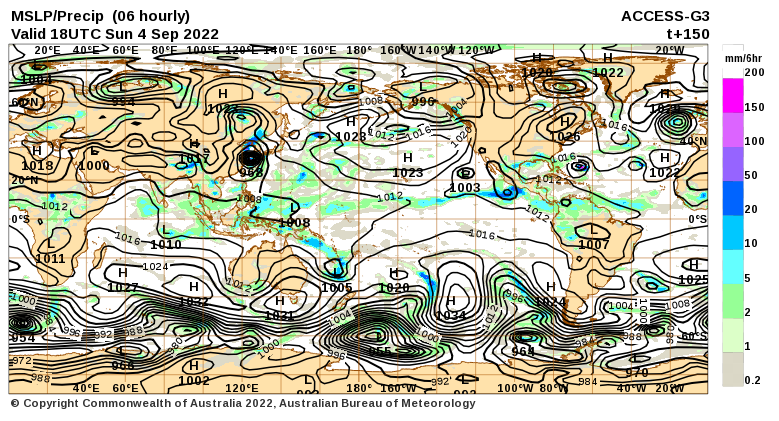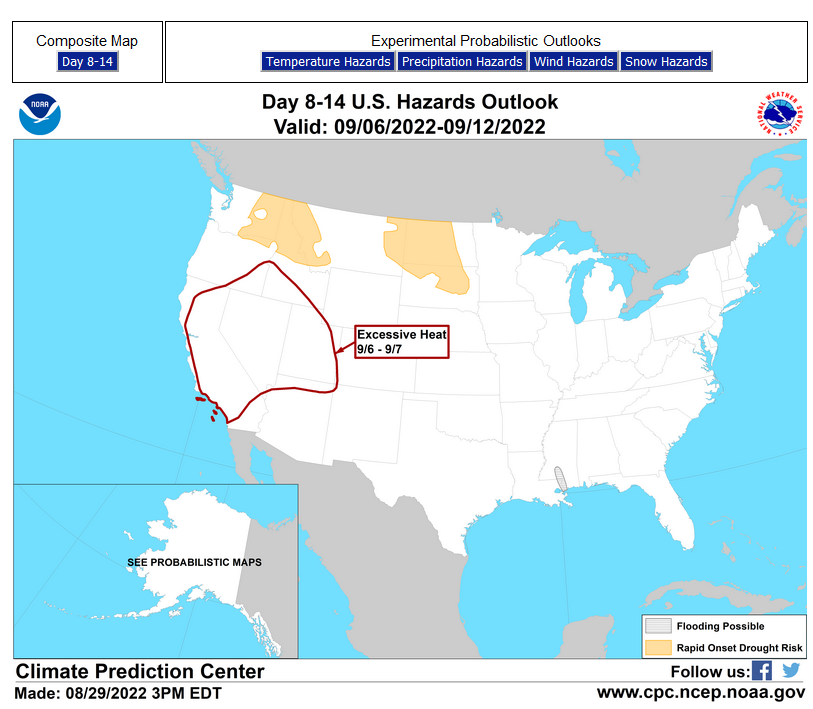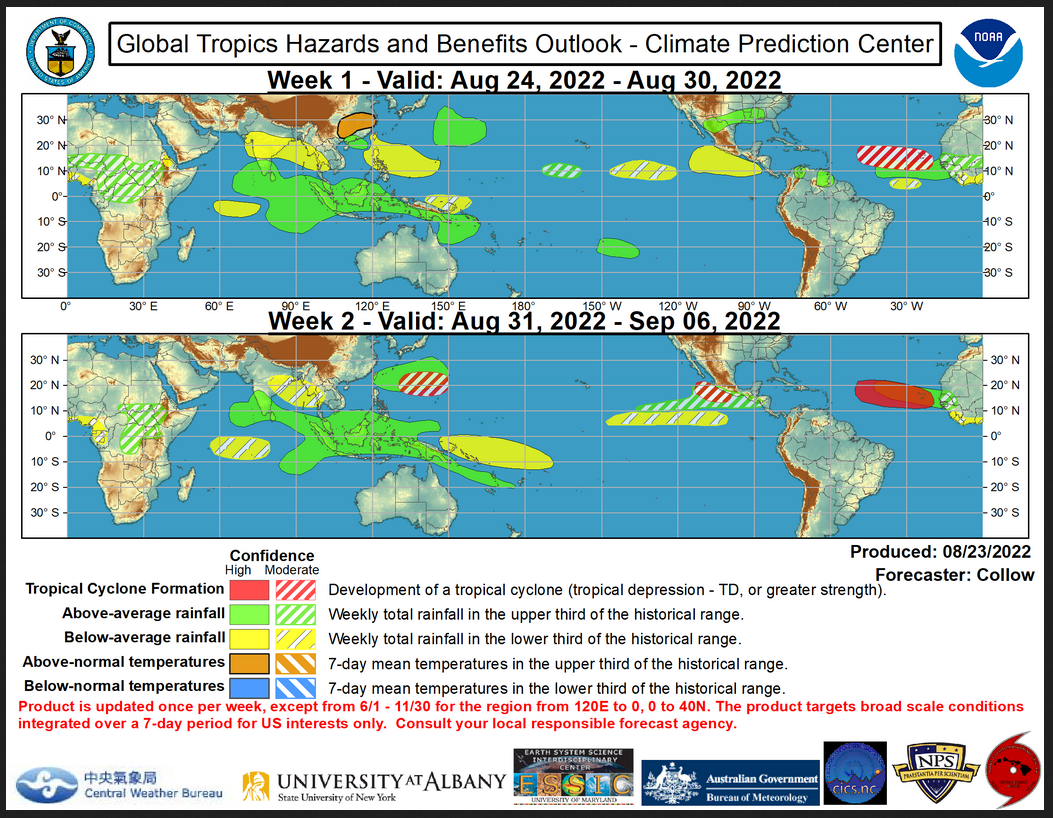Here is what we are paying attention to tonight and the next 48 hours from this evening’s NWS Forecast.
...Slight to enhanced risk of severe thunderstorms across parts of the Midwest tonight... ...Slight risk of excessive rainfall for parts of the Southern Plains and Lower Mississippi Valley tonight... ...Record heat likely to build into parts of the West this week..
Continuation of the NWS Short Range Forecast (It is updated twice a day and these updates can be found here.
A cold front supported by a deep upper-level trough will be the focus for scattered showers and thunderstorms from the Southern Plains to the Midwest/Ohio Valley and the Northeast over the next couple of days. A line of severe warned thunderstorms that initiated over north-central Illinois this afternoon will continue propagating eastward across northern Indiana and Ohio this evening, where damaging winds and hail will be the main threats. A Slight risk with an embedded enhanced were issued by the Storm Prediction Center for these areas. Isolated flash flooding due to heavy rainfall is also possible. There's a higher possibility of excessive rainfall along the southern tip of the cold front in southeastern New Mexico/western Texas and the Gulf coast tonight, where present shortwave energy and moisture may enhance flash flood potential for those areas. Expect scattered thunderstorms from the Lower Great Lakes to the Southern Plains on Tuesday as the cold front moves east and south. Rain and thunderstorm activity shifts into the East Coast and Gulf Coast/Texas by Wednesday as the cold front continues on. A wave of low pressure may develop over southern Quebec leading to enhanced rainfall amounts across parts of the interior Northeast. Abnormally warm air will continue to rise up ahead of the approaching upper trough/cold front in the East, leading to widespread low temperature records being tied or broken tonight from the interior Northeast to the Southern Appalachians. Low temperature records will be contested along the Northeast coast on Tuesday night as the upper/surface feature move east. An upper level-ridge will be responsible for record breaking heat in the West this week. Highs in the 90s and lows in the 60s may be enough to unseat the current temperature records in the West, but particularly in the Pacific Northwest and Northern Rockies on Tuesday. The warm airmass only gets warmer on Wednesday as the upper ridge shifts northward. Highs in the Northern Rockies/Great Basin will be in the upper 90s and low 100s which will likely cause widespread record breaking temperatures. Lows in the West on Wednesday night will remain above normal in the 60s, which will also potentially tie or break records.
Maps that relate the forecast to geography can be found by clicking Here for Day 1 and Here for Day 2.
Here is a 60-hour animated forecast map that shows how the short-term forecast is expected to play out.
If it needs to be updated click here.
HAZARDS OUTLOOKS
Click h ere for the latest complete Day 3 -7 Hazards forecast which updates only on weekdays. Once a week probably Monday or Tuesday I will update the images. I provided the link for readers to get daily updates on weekdays. Use your own judgment to decide if you need to update these images.
Worldwide Tropical Forecast
(This graphic updates on Tuesdays) If it has not been updated, you can get the update by clicking here
Detailed Maps and Reports for the Western Atlantic and the Pacific Oceans
Below are three maps that summarize the situation for the Atlantic, Eastern and Central Pacific. Additional information can be accessed by clicking HERE
First the Atlantic
Click to view the forecast map and have access to additional information https://www.nhc.noaa.gov/gtwo.php?basin=atlc&fdays=5
Then Eastern Pacific
Click to view the forecast map and have access to additional information https://www.nhc.noaa.gov/gtwo.php?basin=epac&fdays=5
Then Central Pacific
Click to view the forecast map and have access to additional information https://www.nhc.noaa.gov/gtwo.php?basin=cpac&fdays=5
And the Western Pacific
Click to view the forecast map and have access to additional information https://www.metoc.navy.mil/jtwc/jtwc.html
Some Intermediate-Term Outlooks
Links to “Outlook” maps and discussions for three time periods. Days 6 – 10, Days 8 – 14, and Weeks 3 and 4. An outlook differs from a forecast based on how NOAA uses these terms in that an “outlook” presents information from deviation from normal and the likelihood of these deviations.
You have to click on the links because they do not update automatically and I do not want to have stale images in the article. But it is not difficult to click on a link and you get a large image plus a discussion. On Fridays in a separate article, we will show the images and provide a link in this article that article. But remember what you will see is the images as of Friday. But here you can get the current images simply by clicking on them. Then hit the return arrow at the upper left of your screen to return to the article. You will not find this information easily anywhere else.
Right now you can find these maps here (We show them every Friday there but you can click above and find them).
World Forecast for Day 6 (Currently Set for Day 6 but the reader can change that)
World Weather Forecast produced by the Australian Bureau of Meteorology. Unfortunately, I do not know how to extract the control panel and embed it into my report so that you could use the tool within my report. But if you visit it Click Here and you will be able to use the tool to view temperature or many other things for THE WORLD. It can forecast out for a week. Pretty cool. Return to this report by using the “Back Arrow” usually found top left corner of your screen to the left of the URL Box. It may require hitting it a few times depending on how deep you are into the BOM tool. Below are the current worldwide precipitation and air pressure forecasts for six days out. They will not auto-update and right now are current for Day 6. If you want the forecast for a different day Click Here I will try to update this map each day but you have the link so you can access the dashboard and get a wide variety of forecasts.I mostly rely on the reader to interpret world maps. For this map, areas of expected precipitation for the date and time shown are clearly shown.The number of High-Pressure systems shown is called the Wave Number. Maybe I will discuss WN someday. But it shows how many Rossby Waves there are around the World. Sometimes they are hard to count. Counting Low-Pressure systems should provide the same WN. Rossby Waves are the way the temperature distribution of the Planet remains in balance. It is basically the science of fluid dynamics. It can be very helpful in predicting the movement of weather patterns. You can snip an area of interest and move it into MS Paint and enlarge it.

Month to Date Information
Month to date Temperature can be found at https://hprcc.unl.edu/products/maps/acis/MonthTDeptUS.png
Month to date Precipitation can be found at https://hprcc.unl.edu/products/maps/acis/MonthPNormUS.png





